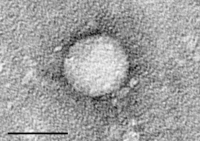
Photo from wikipedia
Chronic hepatitis C virus (HCV) infections affect 71 million people worldwide, often resulting in severe liver damage. Since 2014 highly efficient therapies based on directly acting antivirals (DAAs) are available, offering… Click to show full abstract
Chronic hepatitis C virus (HCV) infections affect 71 million people worldwide, often resulting in severe liver damage. Since 2014 highly efficient therapies based on directly acting antivirals (DAAs) are available, offering cure rates of almost 100%, if the infection is diagnosed in time. It took more than a decade to discover HCV in 1989 and another decade to establish a cell culture model. This review provides a personal view on the importance of HCV cell culture models, particularly the replicon system, in the process of therapy development, from drug screening to understanding of mode of action and resistance, with a special emphasis on the contributions of Ralf Bartenschlager’s group. It summarizes the tremendous efforts of scientists in academia and industry required to achieve efficient DAAs, focusing on the main targets, protease, polymerase and NS5A. It furthermore underpins the importance of strong basic research laying the ground for translational medicine.
Journal Title: Medical Microbiology and Immunology
Year Published: 2018
Link to full text (if available)
Share on Social Media: Sign Up to like & get
recommendations!